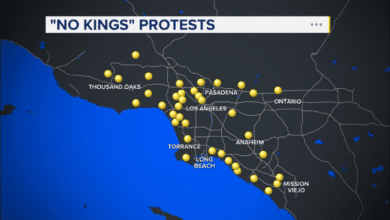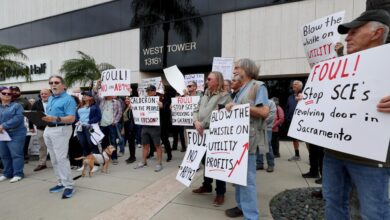After mild fire year, Southern California crews look ahead
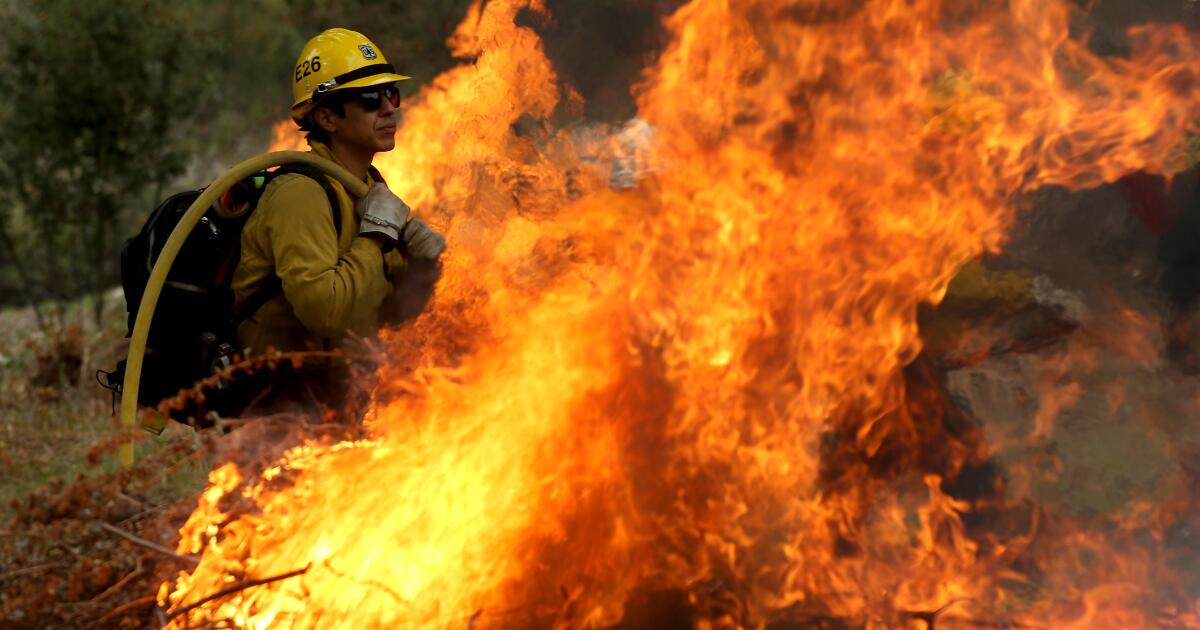
On a cool, cloudy morning last week, Albert Rivas approached a pile of dry wood in the Angeles National Forest and set it on fire.
The pile roared to life, and within minutes, it was spewing flames at least 10 feet tall. Rivas, a firefighter with the U.S. Forest Service, paused briefly to admire his handiwork before aiming his gasoline- and diesel-filled drip torch at another pile nearby.
By morning’s end, he and more than a dozen other Forest Service firefighters had burned about 17 acres’ worth of woody material around the Lower San Antonio Fire Station at the base of Mt. Baldy — a forest management feat they attributed to favorable weather and fuel conditions.
“It’s all about going at it the right way, correctly, with all the techniques,” Rivas said as smoke swirled around him.
A U.S. Forest Service fire crew stands behind the smoking remnants of a controlled burn.
(Luis Sinco / Los Angeles Times)
This year has indeed been favorable for Southern California firefighters. Heavy rains in winter — as well as a rare tropical storm in August — put an end to three years of punishing drought and made the landscape far less likely to burn.
“It was a fairly mild year,” said Robert Garcia, fire chief of the Angeles National Forest. “The fire season started later and, throughout most of the state, ended early. That provided us some reprieve from that intensity to our workforce, but also some tremendous opportunity this year to get out there and do more treatment on the landscape.”
In 2023, there were 92 confirmed fires in the Angeles National Forest, the largest of which was about 420 acres. Statewide, firefighters responded to nearly 6,900 blazes that collectively burned about 320,000 acres, according to data from the California Department of Forestry and Fire Protection.
That’s a far cry from 2020 and 2021, the state’s two worst fire years on record, which together saw nearly 7 million acres burn, including California’s first million-acre fire.
Last year’s acreage was also relatively small — about 363,000 acres — but the blazes claimed more than 700 structures and nine lives.
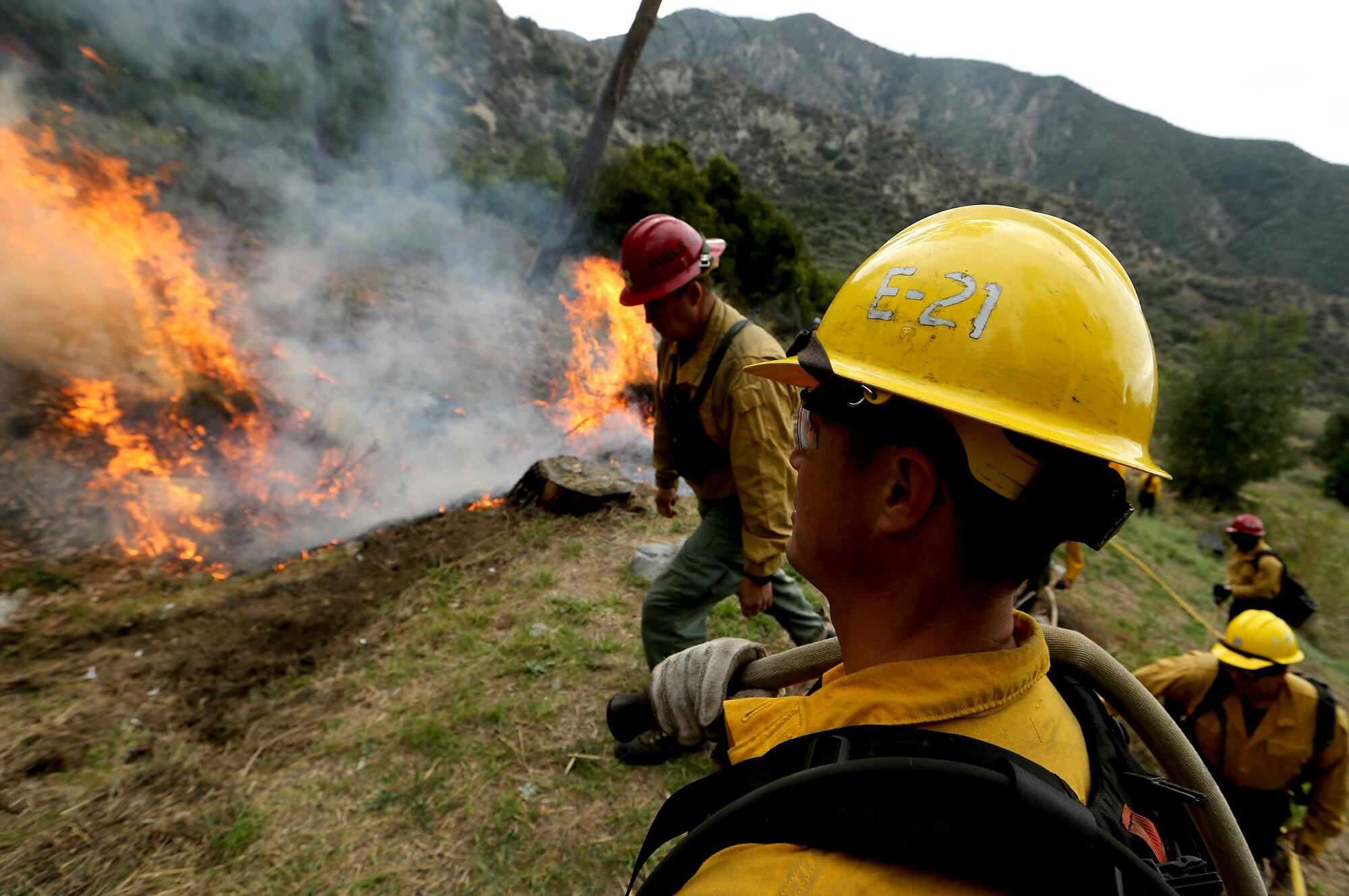
U.S. Forest Service firefighters burn piles of forest debris below Mt. Baldy.
(Luis Sinco / Los Angeles Times)
Garcia attributed much of this year’s tameness to the rains, which ended the “off the charts” dryness that had plagued the landscape in recent years, priming it to burn. What’s more, the weather freed up resources across the state, meaning more crews were able to prepare for fires and respond when they ignited, keeping the numbers small. Some Southern California crews even deployed to assist with larger fires in Oregon, Washington and Canada.
But a mild year is not a year off, he said, and the outlook for 2024 could be affected by the damp conditions this year, which spurred tons of “green-up” in the form of new grasses and vegetation across the region and the state.
“There’s always trade-offs,” Garcia said. “One of the primary benefits [of the rain] is restoring some of the vegetation cycles, but generally speaking, depending on when Mother Nature turns that spigot off, it’s really a matter of how fast those fuels are going to dry out.”
The current seasonal outlook from the National Oceanic and Atmospheric Administration calls for wetter-than-normal conditions in California through at least February, which forecasters say may be supercharged by El Niño. But once the rains stop, all that new vegetation could be fuel for next year’s conflagrations.
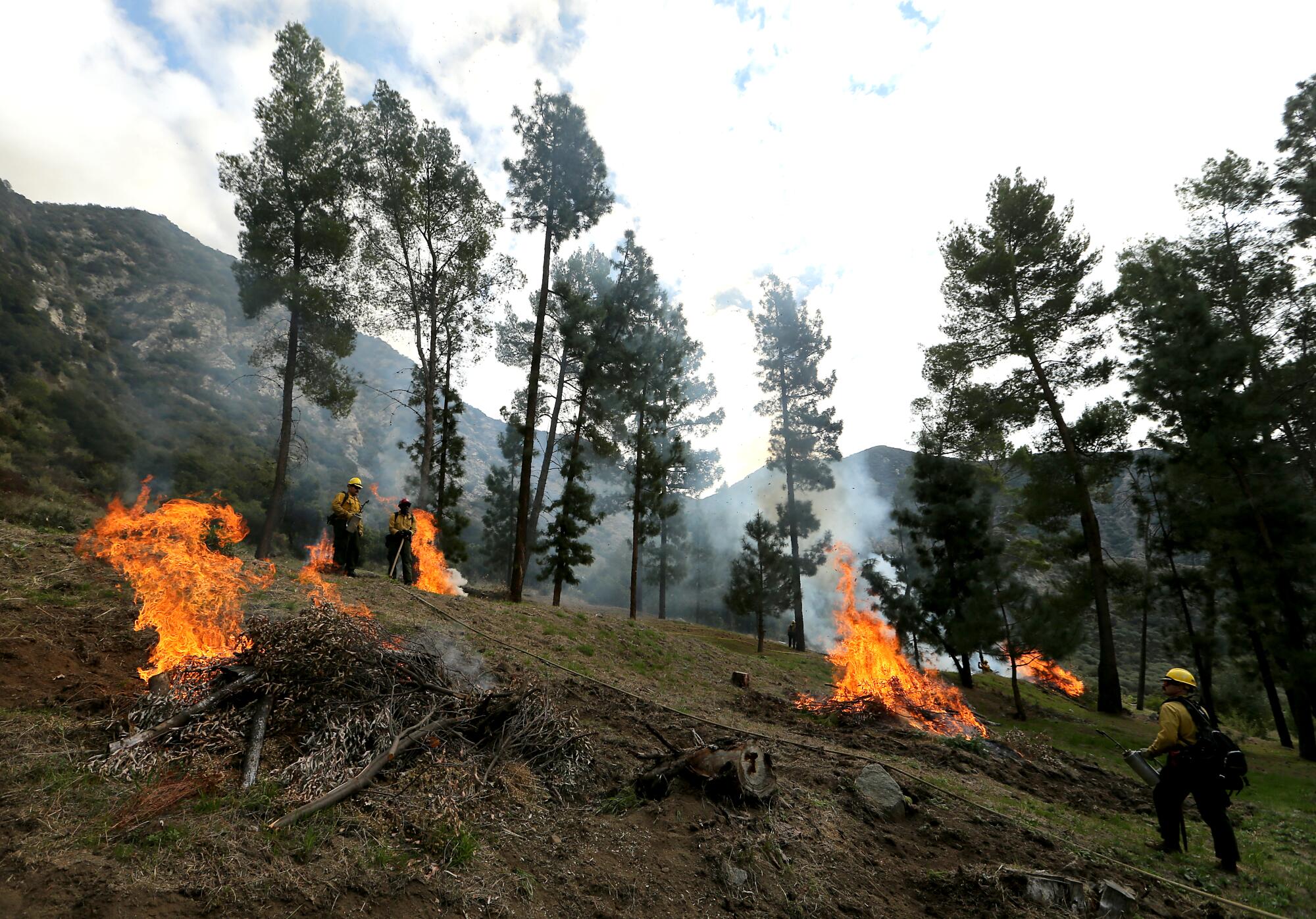
Piles of debris burn on a forested hillside.
(Luis Sinco / Los Angeles Times)
Still, there is no denying this year was beneficial. In the 2023 fiscal year — Oct. 1, 2022, through Sept. 30 — the Forest Service performed mechanical treatments on 261,000 acres of federal forestland in the state. Mechanical treatment includes wood chipping, mastication and removal of trees, branches, leaves, biomass and other material from the forest, which has built up in recent decades and can feed flames.
Forest Service crews in the state also conducted prescribed fires covering 51,614 acres, or fires that are intentionally set to clear out that same material. Firefighters in the Angeles National Forest were able to conduct prescribed burns all the way into June, which they have not been able to do for several years because of drought conditions, and resumed operations in October.
“Fire season historically has ended around November and started up again in May,” said David Gabaldon, a forestry fuels technician with the Forest Service and the “burn boss” at last week’s prescribed burn. “The last probably 10 years now, we’ve almost become a year-round fire department, or fire management group, due to other events like global warming and weather.”
He noted that he recently returned from a prescribed burn in Sequoia and Kings Canyon National Parks, which had been “almost unheard of” in recent years because of the dry conditions.
Like Garcia, Gabaldon was concerned about the new growth this year. The grass was “coming back so quick that we would clear it, and then within two or three months during sprouting season, it would come right back up,” he said. “It’s like doing your yard.”
He hoped that the pile burns last week would act as a reminder to neighboring communities that defensible space efforts and home hardening projects can help protect them during a blaze.
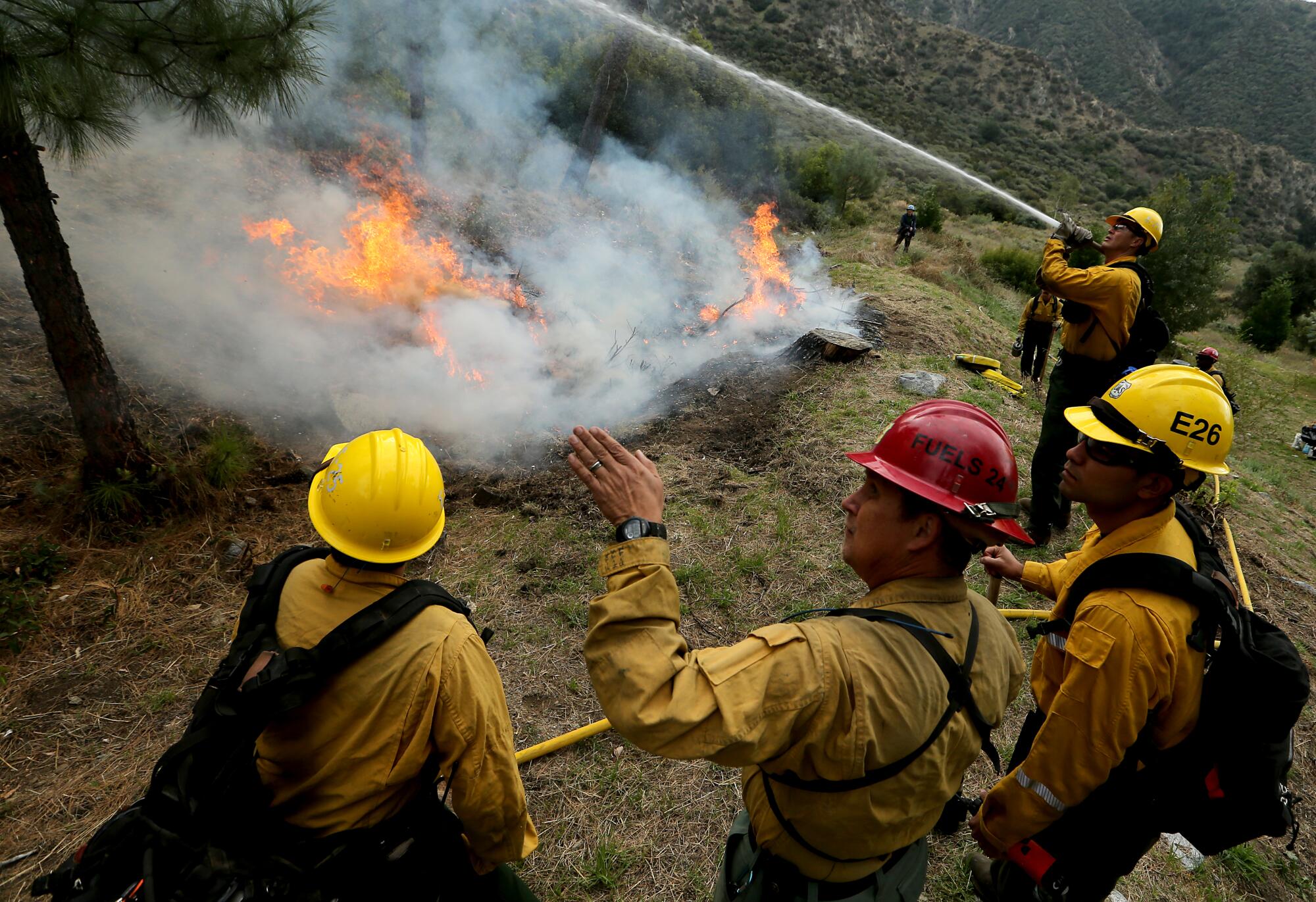
Forest Service crews conducted prescribed fires covering 51,614 acres in California all the way into June, which they have not been able to do for several years because of drought conditions.
(Luis Sinco / Los Angeles Times)
“We’ve got to be the role model, so this is exactly what we’re trying to do here,” he said. “This is good defensible space around our own buildings.”
But challenges remain. Though the agency treated about 313,000 acres in the state this fiscal year, California is home to approximately 33 million acres of forestland — about 19 million acres of which are federally managed. Cal Fire treated about 91,000 acres this year.
What’s more, recent research published in the journal Nature Communications Earth & Environment indicates that climate change is narrowing the window for prescribed burns in the Western United States.
As the planet warms, severe short-term drought will continue to combine with a long-term drying effect known as aridification to reduce adequate burn conditions in the region, the study found, “raising concerns that climate change will add to the many existing challenges to prescribed fire implementation.” By 2060, California could see an additional month or more each year when prescribed burns will be too dangerous.
The Forest Service is also grappling with a retention issue as crews fight for a permanent pay increase from the federal government. Base pay for some firefighters starts at as little as $15 an hour, and thousands have threatened to walk off the force if the pay increase is not finalized.
Garcia said that so far, he has been able to maintain the Angeles National Forest staffing levels, but he hoped to see a resolution soon.

Approximately 17 acres’ worth of material around the Lower San Antonio Fire Station was cleared during the recent controlled burn at the base of Mt. Baldy in Southern California.
(Luis Sinco / Los Angeles Times)
At the same time, teams have benefited from a national wildfire crisis strategy introduced by the Biden administration, he said. The 10-year strategy includes congressional funding geared toward increasing the pace and scale of forest treatments, among other efforts. The strategy has identified Southern California as a priority landscape, Garcia said.
At the pile burn last week, crews were optimistic about such efforts. Mark Muñoz, a suppression battalion chief, said a fire recently sparked in an area of the forest that had been treated earlier in the season, and was quickly extinguished.
“Fighting fire in a treated area versus a non-treated area? Extremely important and crucial,” he said.
Although it may have seemed like a mild season from the outside, the work is nonstop, Muñoz said.
“When we’re not fighting fire, we’re not hanging out on the sofa and watching TV — we’re out here cutting with chainsaws and hand tools, and we’re over here doing prescribed fire,” he said, motioning to the smoldering piles around him. “So 12 months out of the year, we’re still technically fighting fire. Because this is still fighting fire.”
Newsletter
Toward a more sustainable California
Get Boiling Point, our newsletter exploring climate change, energy and the environment, and become part of the conversation — and the solution.
You may occasionally receive promotional content from the Los Angeles Times.


